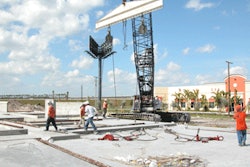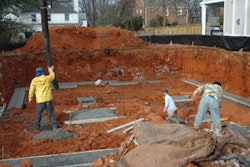The harsh economic realities the nation faced in the last two quarters of 2008 unfortunately will continue well into the New Year. But longer term, the outlook is good. When it comes, the recovery is expected to be as sharp and dramatic as the decline, and all indicators point to it favoring concrete. An anticipated increased emphasis on "green building" and high asphalt prices suggest the concrete industry will more than fully participate in the upcoming construction upturn.
The economic downturn will continue to cause especially tough times for the construction industry. Our industry experienced strong growth during 2003-2005. Even when the residential market started its downward spiral in 2006, the nonresidential sector continued to boom. The old adage is true?what goes up must come down?and we are now definitely in a trough. However, to call on another cliché?nothing lasts forever.
The Portland Cement Association (PCA) expects the economy to weaken through the first half of 2009, with tepid growth materializing in the second half of 2009 and first half of 2010.
While the United States economy is resilient, many separate adversities materialized during 2008 that led to deterioration in growth. These included the sub-prime crisis, high energy prices, the financial melt-down, tight lending standards, elevated inflation, and labor market weakness. While weak economic conditions will reduce the drag on consumers related to inflation and energy prices during 2009, these benefits will be offset by accelerated job losses, continued erosion in confidence (consumer, business, financial), and the emergence of huge state deficits.
Through the first half of 2009, the economy is expected to be characterized by the following conditions:
- Home foreclosures will accelerate and are expected to continue at a high level. The sub-prime crisis is far from over. This implies the "bleed through" to other sectors of the economy will continue to act as a drag on growth for another year. Foreclosure problems are expected to be greatest in California, Arizona, Nevada, Florida and the Great Lakes region.
- Prior to the $700 billion bailout, bank write-downs totaled $500 billion. Accelerated foreclosures imply further bank write-downs ? offsetting the treasury's cash infusions into the banking sector. This may slow an easing in lenders' aversion toward risk. Without an easing in lending standards it will be difficult for the economy to recover.
- Use of credit card debt has accelerated significantly. With many consumers struggling to make higher mortgage payments, the addition of higher credit card payments will contribute to an outright retrenchment in consumer spending. The weight of this debt will not be eased quickly and as a result will act as a strong drag on consumer spending growth.
- The labor market is expected to shed 2 million jobs during 2008 and more than 2 million jobs in 2009. Lacking job creation, consumer spending weakens further and adds momentum to growth deceleration.
- Median home prices will decline by 8% during 2008 and another 9% during 2009. Declining home prices reduces consumer wealth and has shut down lines of credit. In addition, consumer psychology will be adversely impacted by the price declines.
- Consumer confidence is low. Business confidence has crashed. Slower job creation and a general worsening in economic conditions will result in further deterioration in consumer and business confidence. A reduction in overall confidence will reinforce a retreat in consumer and investment spending.
- Tight commercial credit, lower expected ROIs, and reduced earnings will prompt a sustained contraction in business investment reinforcing the expected weakness in consumer spending.
- The economic slowdown is global. United States exports, a significant contributor to recent growth, are expected to weaken significantly.
- Huge state deficits will emerge. Job losses will translate into reduced revenues for states. Entitlement spending will increase. Large cuts in discretionary spending are expected to materialize partially offsetting future potential federal spending stimulus actions.
These severe economic realities translate into weak conditions for the construction industry. In total, real construction spending most likely will decline 9.5% in 2008, 13.9% in 2009, and 0.8% in 2010. Following large 2007 and 2008 declines, residential construction will experience another 18% decline in 2009.
As job losses continue to mount, sub-prime resets will continue to increase leading to higher home inventories and low home sales. PCA does not believe housing starts will begin a meaningful recovery until late 2010.
Nonresidential construction, which provided some support to overall construction activity during the past two years, will drop 23% during 2009 and 12% in 2010. Recovery won't be seen in nonresidential construction until 2011.
States will see lower income and sale tax revenues as their citizens lose their jobs and cut back on spending. Tight credit conditions will make financing of municipal bonds a challenge. All this will create a significant drag on public construction activity.
PCA predicts the states' fiscal crisis will far surpass those encountered following the 2001 recession, causing severe impacts on public construction. State revenue shortfalls during 2009-2010 are expected to exceed the 2002-2003 crises by at least 35%. Public construction could decline roughly 5% annually during 2009-2010. However, the Obama plan, highlighting infrastructure rebuilding, could adjust the public construction sector forecast.
Although it will take time to be put in place and projects to be designed, there already is a reportedly $70 billion in infrastructure projects "ready-to-go" in 90 days and waiting funding. As long as the package continues an "aid-to-states" provision, significant benefits to construction activity could materialize as soon as 2010.
Boom periods typically create imbalances within the economy. During the past boom, exuberant lending practices characterized by the diminution and misunderstanding of risk, exaggerated U.S. and global economic growth. Recessions correct imbalances. Eventually, the return to trend growth will materialize.
PCA expects the construction recovery to be sharp and dramatic. Although it could begin in late 2010 with a return of the residential sector, the recovery will be most noticeable in 2011 and beyond. All sectors should experience positive growth by 2012.
Although we are currently at the bottom of a "V," several dynamics account for longer-term optimism.
- Sub-prime resets are expected to significantly decline starting mid-2009 ? reducing the adverse drag on the economy of foreclosures and alleviating the single-family inventory conditions.
- The $700 billion cash infusion to banks will begin to lead to a gradual easing in credit conditions that will improve throughout 2010.
- Additional infrastructure economic stimulus policies will eventually gain traction and result in the creation of jobs. Positive economic momentum may begin to materialize in full force by mid-2010.
- The continuation of low oil prices will inject as much as $150 billion into consumer pockets compared to 2008.
- The severity and length of the current recession will generate huge pent-up demand for all goods ? including residential and nonresidential construction ? that will eventually be released.
With careful planning and consideration of all the factors today's contractors will be positioned to react when the time is right.



















